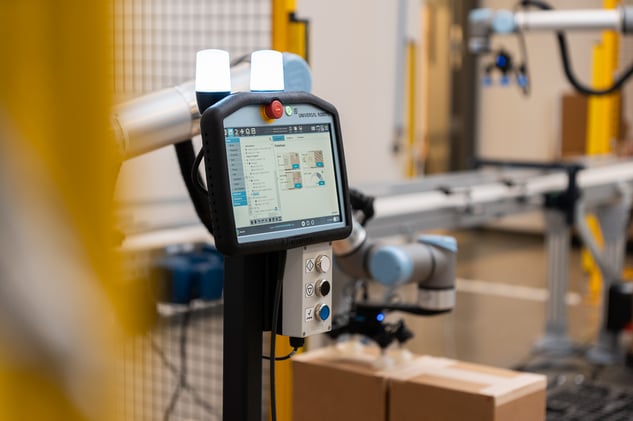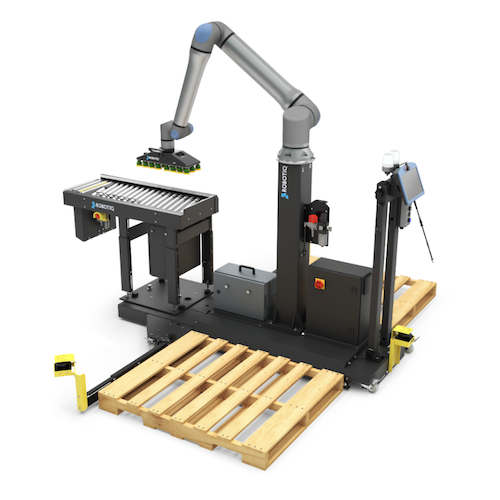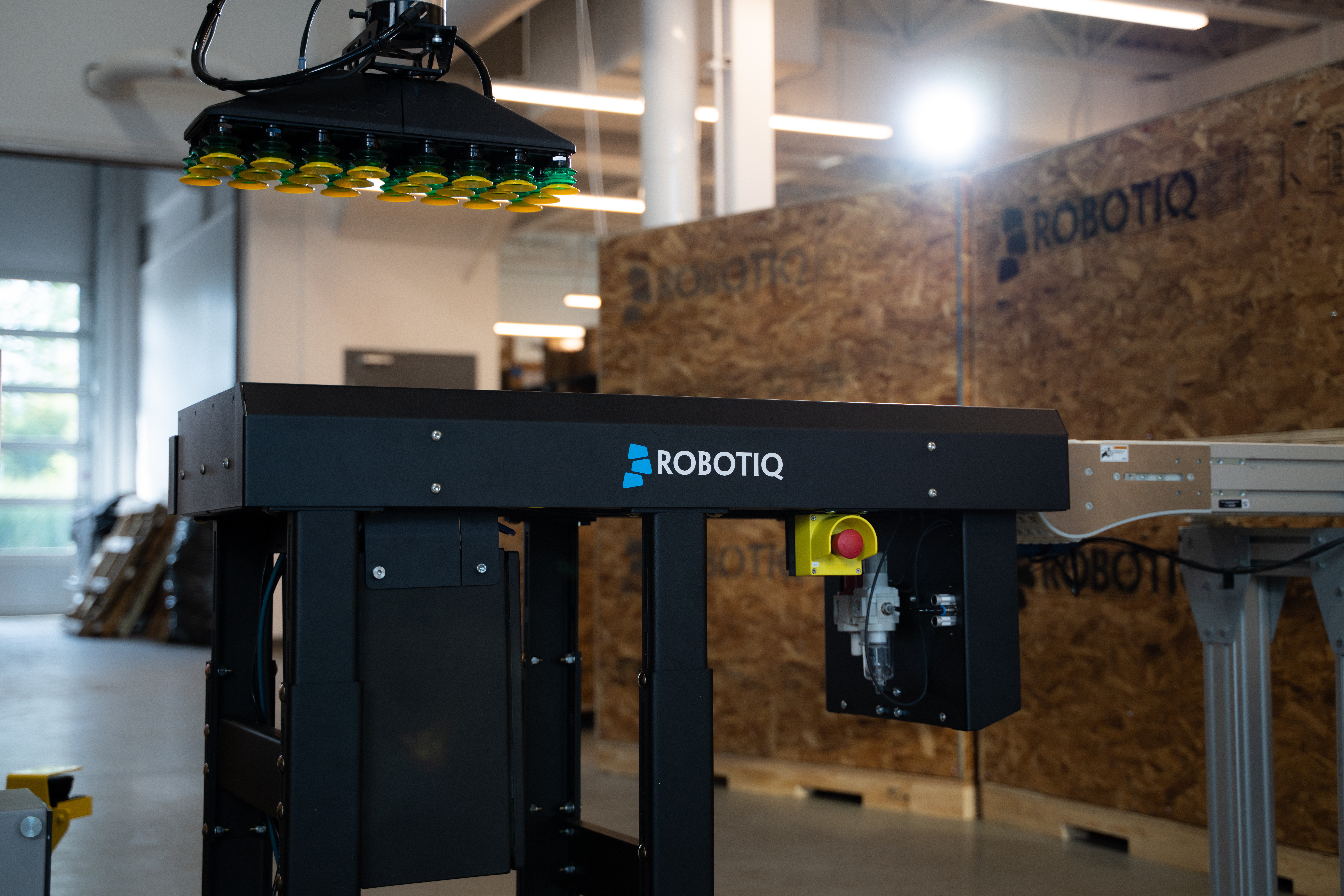How to Setup a Cobot Cell for Efficient De-palletization

Posted on May 24, 2022 in Palletizing
5 min read time
You are receiving raw materials into your facility… all packed onto pallets. How can you make your manual de-palletizing task more efficient?
Collaborative robots are a popular solution for improving palletizing. By automating your task with a cobot, you move the task out of the hands of human workers. This is more efficient, more consistent, and allows the people to perform more value-added tasks that they actually enjoy.
How do you setup a cobot cell for de-palletization?
What are the differences between palletizing and de-palletizing?
Here's how to get a head start by setting up your de-palletizing cell in the right way…
What is the meaning of de-palletization?
De-palletizing simply means taking items off a pallet. It is the opposite of palletizing, where items are arranged in a regular pattern on pallets for shipment. However, although the tasks are very similar, there are extra factors to consider when de-palletizing.
One of the key differences between palletizing and de-palletizing is how you handle the two tasks with an automated solution.
With palletizing, you have complete control over the task. The items arrive for palletizing in a known order, position, and orientation.
With de-palletizing, you don't have this control. Items are not always arranged in the pattern you expect and they may have shifted during transit.
One solution to this problem is to use large and complex layer de-palletizing solutions. These use huge palletizing robots to lift entire layers from the pallets. They usually require a lot of extra automation components around the robot to support this function.
De-palletizing with a cobot is an alternative to these costly solutions. It can involve more complex control than palletizing, but is quite straightforward when you know how.
How de-palletizing compares to palletizing in cell design
There are a few factors to think about when you are designing a cell for cobot de-palletizing. When you keep these in mind, you can reduce the chance of errors later.
Some steps you may need to take with de-palletizing (but don't need for palletizing) are:
-
Prepare for potential unloading challenges caused by how the sender has packed the pallet. Can you negotiate with your suppliers that they will arrange your pallets in a particular way?
-
Consider how loads might move in transit, causing the items to move. How can you counteract these movements when the pallets enter your facility?
-
Consider the various upstream and downstream processes to the de-palletizing. These will be different to those in a palletizing task. How do the downstream processes need the items to be delivered to them? How do the upstream processes (if any) affect the pallet and its load?
7 simple steps to ensure your de-palletizing cell does the job
Setting up a de-palletizing cell is very easy when you know what you are doing.
With collaborative robots, there are relatively few steps needed to achieve a functioning de-palletizing cell. Unlike with conventional automation — which can take months to install — you can set up a cobot in several hours.
Here are the 7 steps for setting up a cobot de-palletizing cell:
1. Look at your current manual de-palletizing task
Before you design your cobot cell, look at how you currently perform the de-palletizing task.
Get clear on your de-palletizing workers' current manual steps. Map out your manual palletizing task, including steps like removing shrinkwrap or cutting packing ties.
2. Consider how the pallets come into your facility and in what state
Look critically at the pallets that arrive from your suppliers.
Consider how neatly the items are stacked on the pallets and how consistent the patterns are. Think about how you can either remove any inconsistencies or overcome them with the robot.
3. Look at the downstream processes after de-palletization
We often encourage robot users to consider the downstream processes as the robot's "customers."
With de-palletizing, there may be many such "customer processes" in your facility – i.e. processes that are fed by the robot. Clarify with them how they like to receive items after de-palletizing.
4. Measure the task on the Value vs Complexity graph
A good way to evaluate a task for robotic automation is to map it on a Value vs Complexity graph.
The best robot tasks are those that will have high value for your company and are not complex to deploy. You can find out how to do this for your task in our free palletizing course.
5. Design your robot cell
When you have done all of your preparation, it's time to design the robot cell for your de-palletizing task.
This need not be complex. Start with your manual task map and use this to help you design the robot cell.
6. Carry out your integration process
After designing the cell, the only thing you need to do is set up the robot hardware and program it.
Collaborative robot integration is much easier than conventional robotic automation. You don't even need previous robotics experience.
7. Track your metrics and improve the cell over time
Finally, set metrics for the running of your robot. This will help you to objectively analyze the performance of the de-palletizing cell and improve it over time.
Not sure what metrics to choose? Grab a copy of our free eBook on the top metrics for cobots.
How to setup the cobot hardware for de-palletization
What's involved in the physical integration of a de-palleitizing cobot?
The steps are very simple. You can usually setup the robot in under an hour.
Here are the 7 steps to setup a de-palletizing robot:
-
Install the robot itself.
-
Install your end effector.
-
Install the cable management system.
-
Connect the electrical cables and components.
-
Add the box and pallet sensors.
-
Anchor the solution in place.
-
Start programming.
Want to see these steps in action? Sign up to our free palletizing eLearning course. It guides you through the entire process of designing and deploying a cobot palletizing cell.

To see how companies just like yours are using cobot palletizing, check out our palletizing applications page.
What challenges do you think a de-palletizing robot would have in your business? Tell us in the comments below or join the discussion on LinkedIn, Twitter, Facebook, or the DoF professional robotics community.



-modified.png)


-2.jpg)

Leave a comment